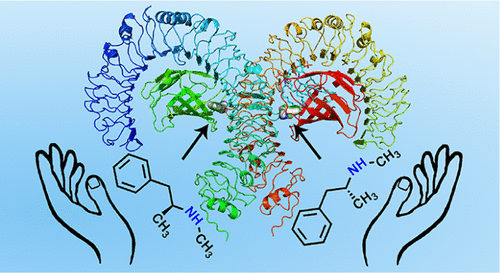当前位置:
X-MOL 学术
›
J. Chem. Inf. Model.
›
论文详情
Our official English website, www.x-mol.net, welcomes your feedback! (Note: you will need to create a separate account there.)
Exploring Methamphetamine Nonenantioselectively Targeting Toll-like Receptor 4/Myeloid Differentiation Protein 2 by in Silico Simulations and Wet-Lab Techniques.
Journal of Chemical Information and Modeling ( IF 5.6 ) Pub Date : 2020-01-14 , DOI: 10.1021/acs.jcim.9b01040 Xiaozheng Zhang 1 , Yibo Wang 1 , Hongshuang Wang 1 , Hongyuan Li 1 , Tianshu Zhang 1 , Yinghua Peng 2 , Xiaohui Wang 1, 3
Journal of Chemical Information and Modeling ( IF 5.6 ) Pub Date : 2020-01-14 , DOI: 10.1021/acs.jcim.9b01040 Xiaozheng Zhang 1 , Yibo Wang 1 , Hongshuang Wang 1 , Hongyuan Li 1 , Tianshu Zhang 1 , Yinghua Peng 2 , Xiaohui Wang 1, 3
Affiliation

|
Methamphetamine (METH) is one of the highly addictive nonopioid psychostimulants, acting as a xenobiotic-associated molecular pattern (XAMP) to target TLR4 and activate microglia. However, the molecule recognition of METH by innate immune receptor TLR4/MD-2 is not well-understood. METH exists in two enantiomeric forms, and it is unclear whether the TLR4 innate immune recognition with METH is stereoselective. Herein, molecular dynamics (MDs) simulations were performed to dissect the recognition of (+)-METH and (-)-METH by TLR4/MD-2 at the atomic level. Amphetamine (AMPH), which is an analogue of METH, was also investigated for comparison. Computational simulations indicate that METH binds into the interaction interface between MD-2 as well as TLR4* that is from the adjacent copy of TLR4-MD-2, therefore stabilizing the active heterotetramer (TLR4/MD-2)2 complex. The calculated binding free energies and potential of mean force (PMF) values show that (-)-METH and (+)-METH have similar TLR4/MD-2 binding affinity. Further dynamics analyses of bindings with TLR4/MD-2 indicate that (-)-METH and (+)-METH behave similarly. Unlike the stereoselective neuron-stimulating activities of METH, no enantioselectivity was observed for METH interacting with TLR4/MD-2 complex as well as activating TLR4 signaling. Compared to METH, AMPH showed much weaker interactions with TLR4/MD-2, indicating that the substituted methyl group is critical in the molecular recognition of METH by TLR4/MD-2. In all, this study provides molecular insight into the innate immune recognition of METH, which demonstrates that METH could be nonenantioselectively sensed by TLR4/MD-2.
中文翻译:

通过计算机模拟和湿实验室技术探索甲基苯丙胺非对映选择性靶向Toll样受体4 /骨髓分化蛋白2。
甲基苯丙胺(METH)是一种高度上瘾的非阿片类精神兴奋剂,可作为异种生物相关分子模式(XAMP)靶向TLR4和激活小胶质细胞。但是,先天免疫受体TLR4 / MD-2对METH的分子识别尚不为人所知。METH以两种对映体形式存在,尚不清楚METH的TLR4先天免疫识别是否具有立体选择性。在本文中,进行了分子动力学(MDs)模拟以在原子水平上剖析TLR4 / MD-2对(+)-METH和(-)-METH的识别。还对苯丙胺(AMPH)(一种甲基苯丙胺类似物)进行了比较研究。计算仿真表明,METH绑定到MD-2和TLR4 *之间的交互界面中,而交互接口来自TLR4-MD-2的相邻副本,因此可以稳定活性异四聚体(TLR4 / MD-2)2复合物。计算的结合自由能和平均力势(PMF)值表明(-)-METH和(+)-METH具有相似的TLR4 / MD-2结合亲和力。与TLR4 / MD-2结合的进一步动力学分析表明,(-)-METH和(+)-METH表现相似。与METH的立体选择性神经元刺激活性不同,未观察到METH与TLR4 / MD-2复合物相互作用以及激活TLR4信号传导的对映选择性。与METH相比,AMPH与TLR4 / MD-2的相互作用弱得多,表明取代的甲基对于TLR4 / MD-2识别METH至关重要。总之,这项研究为METH的先天免疫识别提供了分子洞察力,
更新日期:2020-01-14
中文翻译:

通过计算机模拟和湿实验室技术探索甲基苯丙胺非对映选择性靶向Toll样受体4 /骨髓分化蛋白2。
甲基苯丙胺(METH)是一种高度上瘾的非阿片类精神兴奋剂,可作为异种生物相关分子模式(XAMP)靶向TLR4和激活小胶质细胞。但是,先天免疫受体TLR4 / MD-2对METH的分子识别尚不为人所知。METH以两种对映体形式存在,尚不清楚METH的TLR4先天免疫识别是否具有立体选择性。在本文中,进行了分子动力学(MDs)模拟以在原子水平上剖析TLR4 / MD-2对(+)-METH和(-)-METH的识别。还对苯丙胺(AMPH)(一种甲基苯丙胺类似物)进行了比较研究。计算仿真表明,METH绑定到MD-2和TLR4 *之间的交互界面中,而交互接口来自TLR4-MD-2的相邻副本,因此可以稳定活性异四聚体(TLR4 / MD-2)2复合物。计算的结合自由能和平均力势(PMF)值表明(-)-METH和(+)-METH具有相似的TLR4 / MD-2结合亲和力。与TLR4 / MD-2结合的进一步动力学分析表明,(-)-METH和(+)-METH表现相似。与METH的立体选择性神经元刺激活性不同,未观察到METH与TLR4 / MD-2复合物相互作用以及激活TLR4信号传导的对映选择性。与METH相比,AMPH与TLR4 / MD-2的相互作用弱得多,表明取代的甲基对于TLR4 / MD-2识别METH至关重要。总之,这项研究为METH的先天免疫识别提供了分子洞察力,



























 京公网安备 11010802027423号
京公网安备 11010802027423号